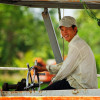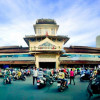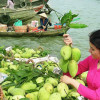Bangkok Travel Tips – Things to know before your travel to Thailand
If you’re planning to go to Bangkok, Thailand, get ready to dive into a city that’s bursting with life, culture, and endless adventures. Whether you’re wondering about the best time to visit, what to pack, or how to get around, we’ve got you covered. This guide will walk you through everything you need to know before your journey, ensuring you experience the best that Bangkok has to offer. Let’s get started!

I. Is Bangkok safe for travel?
Bangkok, Thailand’s bustling capital, is generally considered a safe destination for travelers. Like any major city, it has its challenges, but with some precautions, visitors can enjoy a memorable and safe trip. According to Numbeo, Bangkok got 59.89 safety score (100 is most safe).
Here’s a closer look at what you should know:
- Petty Crime: While serious crime is rare, pickpocketing can happen in crowded places, especially tourist spots and public transport. Keep your things safe and stay aware of your surroundings.
- Scams: Tourists often face scams like taxi overcharging and fake gem shops. Always use trusted services, agree on taxi prices before getting in, or use ride-hailing apps.
- Traffic: Bangkok has heavy traffic, and crossing the street can be tough. Use pedestrian bridges when you can, and be careful near busy roads.
- Health Tips: Stay hydrated and be careful with street food to avoid getting sick. Mosquitoes can carry diseases like dengue fever, so use insect repellent.
In summary, Bangkok is safe for travel if you stay aware and cautious. With some planning and awareness, you can enjoy all that this lively city offers without any big worries.
II. What is the best time to visit Bangkok?
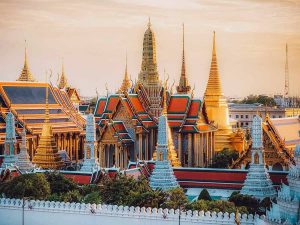
Bangkok has a tropical climate with three main seasons: hot (March to June), rainy (July to October), and cool (November to February).
The cool season from November to February is usually the best time to visit Bangkok. The temperatures are more comfortable, between 26-28°C, and there’s less rain. This is perfect for sightseeing and outdoor fun. However, it is also the most crowded and expensive time for tourists.
The hot season from March to June can be uncomfortably warm, with temperatures often exceeding 30°C. While it’s less crowded, the heat can make exploring the city challenging. The rainy season from July to October sees frequent showers and higher humidity. This can disrupt outdoor plans, but it also means fewer tourists and lower prices. Some travelers enjoy the lush greenery and cooler temperatures that the rains bring.
For the best balance of good weather and manageable crowds, aim to visit Bangkok in November or early December. You’ll enjoy pleasant temperatures and avoid the peak holiday rush while still experiencing the city’s vibrant atmosphere.
III. Do I need a SIM for Bangkok?
Yes, you generally need a SIM card for Bangkok. Here’s why:
- Access maps, translation apps, and travel information
- Communicate with locals and other travelers
- Book rides, accommodations, and tours on-the-go
- Share your experiences on social media
- Access emergency services if needed
Besides physical SIM, you should know about eSIM. I consider this to be a great invention of mankind. An eSIM is a digital SIM that lets you activate a cellular plan without poping a physical SIM card into your device.
If you’re looking for easy eSIM options in Thailand, I really recommend thailandesim.com. They send the eSIM to your email just 5 minutes after you pay. They have eSIMs for multiple countries, like Singapore and Thailand, or Thailand, Vietnam, and Cambodia. Plus, their prices are good, ranging from about $3.50 to $35.50, depending on how long you need it and how much data you want.
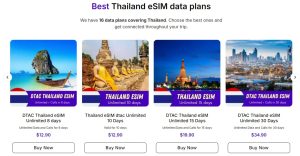
IV. What to pack for Bangkok?
Bangkok has a hot and humid climate all year. It’s a busy city with modern features and traditional culture. When packing, think about the weather and local customs, especially if you plan to visit temples.
Essential Items:
- Passport and travel documents (visa, flight itinerary, etc.)
- Plane ticket and hotel reservation
- Travel insurance information
- Debit/credit cards and cash (Thai baht)
- A small daypack for daily excursions
- Power adapter for charging electronic devices (Bangkok uses Type A, B, and C power sockets)
- Prescription medication and any necessary medical equipment
Clothing:
- Lightweight and breathable clothing (t-shirts, tank tops, shorts, etc.)
- Long-sleeved shirts and pants for temple visits or cooler evenings
- Comfortable walking shoes or sandals
- Socks and undergarments
- A light jacket or sweater for air-conditioned spaces
- Dressy outfit for nice restaurants or cultural events (optional)
- Quick-drying towel and swimwear (if applicable)
Miscellaneous Items:
- Sunscreen and sun hat
- Insect repellent
- Umbrella or raincoat (in case of sudden rain showers)
- Earplugs and eye mask (for better sleep)
- Snorkeling gear or other activity-specific equipment (if applicable)
- Guidebook, map, or downloaded maps on your smartphone
- Portable charger for your phone or other devices
What Not to Bring:
Leave behind valuable items like expensive jewelry or family heirlooms. Don’t pack anything that might be seen as culturally disrespectful, like revealing clothes or items with Buddha images.
Also, Thailand has strict rules about certain items, including e-cigarettes and some medications, so make sure to check and follow local laws.
Always leave extra space in your bag for souvenirs. Smart packing lets you enjoy everything Bangkok has to offer!
V. How much does a trip to Bangkok cost?
Traveling to Bangkok can be very affordable, with a mix of culture, tasty food, and lively city life. Whether you’re on a budget or looking for luxury, Bangkok has options for everyone in terms of places to stay, eat, get around, and have fun.
Expense Categories:
- Accommodation:
- Budget: $10 – $30 per night (Hostels, budget hotels)
- Mid-range: $40 – $100 per night (3-4 star hotels)
- Luxury: $150+ per night (5-star hotels, luxury resorts)
- Food:
- Street food: $1 – $5 per meal
- Casual dining: $5 – $15 per meal
- Fine dining: $30+ per meal
- Transportation:
- BTS Skytrain/MRT: $0.50 – $2 per trip
- Taxis: Starting at $1.15 (plus distance-based fare)
- Tuk-tuks: $2 – $10 (depending on distance and negotiation)
- Public buses: $0.30 – $1
- River taxis: $0.30 – $1.65 per trip
- Activities:
- Sightseeing (e.g., Grand Palace, Wat Arun): $3 – $15 per entry
- Shopping (e.g., Chatuchak Market): Varies by items
- Day trips (e.g., Floating markets, Ayutthaya): $30 – $70
Sample Budget Table:
| Travel Style | Daily Budget (Per Person) | Accommodation | Food | Transportation | Activities |
| Budget | $30 – $50 | $10 – $30 | $5 – $10 | $3 – $5 | $5 – $10 |
| Mid-range | $70 – $150 | $40 – $100 | $10 – $20 | $5 – $10 | $10 – $20 |
| Luxury | $200+ | $150+ | $30+ | $10 – $20 | $20+ |
Money-Saving Tips:
- Choose Budget Stays: Stay in guesthouses, hostels, or budget hotels in popular areas like Khao San Road or Sukhumvit. Book online in advance for discounts.
- Enjoy Street Food: Bangkok’s street food is tasty and affordable, with options available at markets like Chatuchak and in Silom and Chinatown.
- Use Public Transport: The BTS Skytrain, MRT, and buses are cost-effective ways to navigate the city.
- Explore Free Attractions: Many temples and parks are free or low-cost, providing a budget-friendly way to enjoy the city.
- Negotiate Prices: Bargain when shopping in markets; it’s common and can save you money.
In general, you can plan a trip to Bangkok on any budget, with daily costs from $30 for budget travelers to $400 or more for luxury seekers.
VI. Best things to do in Bangkok
Bangkok has many exciting things to do. From old temples and busy markets to tall buildings and tasty street food, there’s something for everyone. Here are the top attractions and activities for your Bangkok trip:
- The Grand Palace
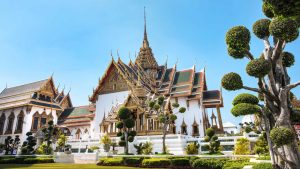
The Grand Palace is one of Bangkok’s most iconic landmarks and a must-visit attraction. This sprawling complex has been the official residence of the king and queen of Thailand since 1782 and features a stunning array of temples, halls, and gardens. Be sure to dress modestly and arrive early to avoid the crowds.
- Location: 1 Sanam Chai Road, Phra Borom Maha Ratchawang, Bangkok
- Hours: 8:30am-3:30pm
- Cost: 500 THB
- Wat Phra Kaew

Located within the Grand Palace complex, Wat Phra Kaew is a temple complex that houses the revered Emerald Buddha, a highly revered Buddha image. This temple is a sacred site for Thai people and is known for its stunning architecture and beautiful gardens.
- Location: 1 Sanam Chai Road, Phra Borom Maha Ratchawang, Bangkok
- Hours: 8:30am-3:30pm
- Cost: 500 THB
- Wat Arun
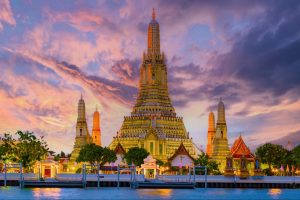
Wat Arun, also known as the Temple of the Dawn, is a stunning temple located on the west bank of the Chao Phraya River. This 17th-century temple is known for its beautiful architecture and stunning views of the city.
- Location: 158 Thanon Wang Doem, Wat Arun, Bangkok Noi, Bangkok
- Hours: 8am-6pm
- Cost: 100 THB
- Floating Markets
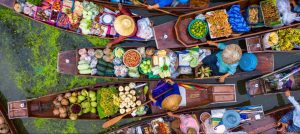
Bangkok’s floating markets are a unique and fascinating experience. Take a boat ride through the canals and explore the vendors selling everything from fresh produce to souvenirs.
- Location: Damnoen Saduak Floating Market, Damnoen Saduak, Ratchaburi
- Hours: 7am-5pm
- Cost: 400 THB per person or 2000 THB for a one-hour paddle boat ride (up to 6 people).
- Khao San Road

Khao San Road is a famous backpacker street in Bangkok, known for its lively nightlife, street food, and affordable accommodations. This is a great place to meet other travelers and experience the city’s vibrant energy.
- Location: Khao San Road, Bang Lamphu, Bangkok
- Hours: 8am-5pm
- Cost: Free admission
VII. What to buy in Bangkok, Thailand?
Shopping in Bangkok is an amazing experience. The city is a paradise for shoppers, with a wide range of products for every taste and budget. Let’s see what to buy here.
- Textiles
Bangkok is famous for its stunning textiles, including silk, cotton, and linen. You can find beautiful fabrics, scarves, and clothing at affordable prices. Some of the best places to find high-quality textiles include:
- Chatuchak Weekend Market: This massive market offers a vast array of textiles, from traditional Thai fabrics to modern designs.
- MBK Center: This popular mall has a dedicated floor for textiles, offering a wide range of fabrics and clothing.
- Siam Paragon: This upscale mall features a luxury textile section with high-end fabrics and designer clothing.
- Handicrafts
Bangkok is home to a wide range of traditional handicrafts, including wood carvings, pottery, and metalwork. Some of the best places to find unique handicrafts include:
- Jim Thompson House: This museum showcases traditional Thai handicrafts, including textiles, woodcarvings, and pottery.
- Bangkok National Museum: This museum features a collection of traditional Thai handicrafts, including metalwork and wood carvings.
- Floating Markets: Visit the floating markets to find unique handicrafts, including handmade wooden toys and decorative items.
- Food Products
Bangkok is a food lover’s paradise, and you can find a wide range of delicious food products, including spices, sauces, and snacks. Some of the best places to find food products include:
- Chatuchak Weekend Market: This market offers a vast array of food products, including spices, sauces, and snacks.
- MBK Center: This mall has a dedicated floor for food products, offering a wide range of Thai delicacies.
- Siam Paragon: This upscale mall features a luxury food section with high-end food products and gourmet snacks.
VIII. What to eat in Bangkok?
Thai food is a treasure loved by food lovers everywhere. In Bangkok, the capital of Thailand, you can enjoy a lively food scene that highlights the country’s rich cooking traditions. Let’s explore what’s available!
- Must-Try Thai Dishes

Here are some of the most popular and delicious Thai dishes you should try when visiting Bangkok:
- Pad Thai: Stir-fried rice noodles with shrimp, tofu, and vegetables, flavored with tamarind and fish sauce.
- Tom Yum Goong: Spicy and sour soup made with shrimp, lemongrass, and mushrooms.
- Som Tam (Papaya Salad): Spicy and sour salad made with shredded green papaya, tomatoes, chilies, and peanuts.
- Massaman Curry: Rich and slightly sweet curry made with beef or chicken, potatoes, and peanuts.
- Satay: Grilled meat skewers, typically made with chicken, beef, or pork, and served with peanut sauce.
- Khao Soi: Curried noodle soup made with boiled egg noodles, braised beef or pork, and a variety of vegetables.
- Larb (Meat Salad): Spicy salad made with minced meat (chicken, beef, or pork), herbs, and chilies.
- Khao Niew Mamuang (Mango with Sticky Rice): Sweet and creamy dessert made with glutinous rice, mango, and coconut milk.
- Where to Find the Best Street Food and Restaurants?
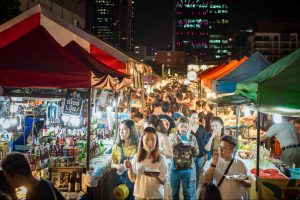
- Chatuchak Weekend Market: This big market has many food stalls with everything from classic Thai dishes to modern fusions.
- Night Markets: Markets like Rot Fai and Patpong offer grilled meats, seafood, and desserts.
- Street Food Stalls: Check out stalls in busy areas like Sukhumvit Road, Silom Road, and Ratchada Road.
For a more upscale dining experience, try:
- Gaggan: A Michelin-starred restaurant serving modern Indian cuisine.
- Bo.Lan: A Michelin-starred restaurant serving traditional Thai cuisine.
- Sra Bua by Kiin Kiin: A Michelin-starred restaurant serving modern Thai cuisine.
IX. Getting around Bangkok
Bangkok’s transport system consists of roads, trains, and waterways, which can be confusing for visitors. However, with some planning, you can easily get around the city. Options include public buses, trains, taxis, tuk-tuks, and boats.
- Transportation Options in Bangkok
- BTS (Skytrain): start at 15 THB per one-stop
- MRT (Subway): starts at 17 THB and can reach a maximum of 45 THB
- Taxis: ~ 40 THB for the first kilometer to ~ 10.50 THB per kilometer for distances over 80 kilometers
- Tuk-tuks: ~ 50–500 THB, or about $1.50–$15, depending on the distance and time of day
- Boats: ~ 60 THB for a single trip, or 200 THB for a day pass
- Public Buses: ~ 8–10 THB
- Navigation Apps and Tools
There are many navigation apps and tools available to help you get around Bangkok, including:
- Google Maps: A comprehensive and accurate mapping app that can help you navigate the city.
- Waze: A GPS navigation app that can help you avoid traffic and find the fastest route.
- Grab: A ride-hailing app that can help you book a taxi or tuk-tuk.
- Moovit: A public transportation app that can help you plan your route and track your journey.
X. Conclusion
I hope you find these Bangkok travel tips helpful as you prepare for your adventure in Thailand. With a mix of culture, vibrant city life, and mouthwatering food, Bangkok promises an unforgettable experience. Whether it’s navigating the bustling streets or exploring serene temples, a little preparation will go a long way in making your trip smooth and enjoyable. Enjoy your travels!

